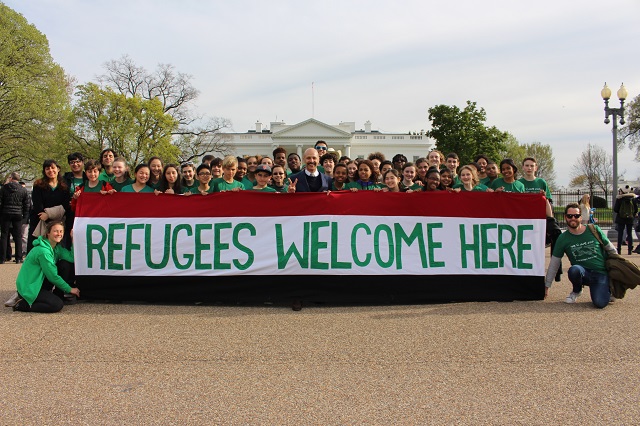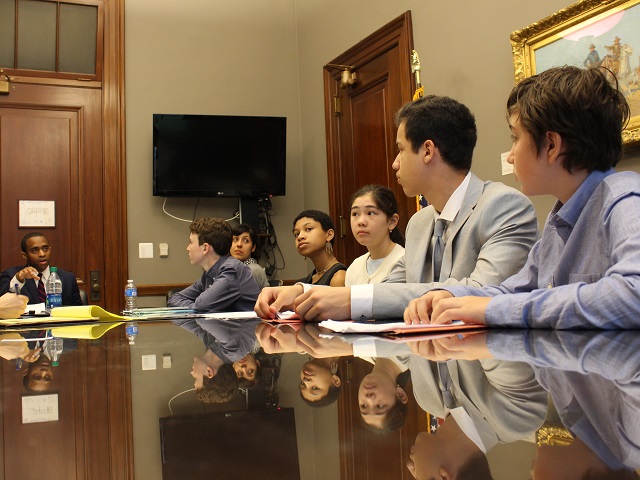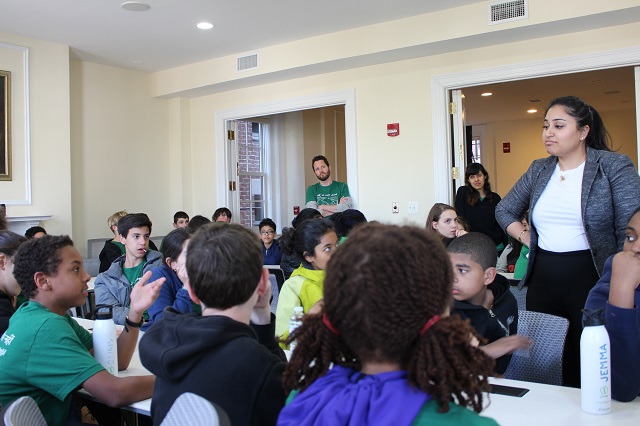
On the last day before spring break at Manhattan Country School, a progressive school in New York City, the 7th and 8th graders were busy at work with their activism campaign, “Build Bridges, Not Borders.” In one classroom, a group of students gathered near the phone, waiting for their turn to call Gov. Andrew Cuomo’s office to encourage the resettlement of Syrian refugees in New York. In another room, students practiced their talking points and arguments in anticipation of their lobbying trip to Washington, DC, where they would ask congressional representatives to oppose bills that would block the refugee resettlement process and sign a resolution that would condemn hateful rhetoric against Muslims in the United States.
Groups of students rotated through the various classrooms until they arrived at a mock refugee screening process. Here, teachers pretended to be interrogators and security agents as they took the students through the nine steps asylum seekers have to go through before they even enter the United States, and explaining that there are more steps after that and that it takes an average of 18-24 months to complete the process. The idea was to refute the common argument that a “terrorist” or ISIS member may come into the country disguised as a Syrian refugee, and to help the students understand what refugees who are escaping war and violence have to go through as they attempt to resettle.
This is not a standard curriculum course, but it is part of what 7th and 8th graders learn in a school committed to activism and social justice.
Each year, the 7th and 8th graders at this sliding-scale tuition school in New York City, where I teach Spanish, vote on a topic for their class to take on with activism. This year, a group of 38 students decided to tackle Islamophobia and raise money to go to Washington, DC, to participate in the National Day of Action led by the American Immigration Lawyers Association (AILA) and lobby to let more Syrian refugees into the United States. The students searched for answers to questions, such as: What is Islamophobia? What is Islam? Is ISIS representative of Islam? How did Muslim scholars and scientists contribute to the European Renaissance? What is the experience of a Syrian person who is trying to resettle in the United States? How can we speak out against hate speech and anti-Muslim bigotry? This inquiry was a central part of the education of these 13- and 14-year-olds as they created and carried out their activism campaign.
Teaching About Reality Without Giving Up Hope
Teaching activism to middle school students matters. Years before high school and college, when the need to belong is at its strongest — young teens want to be part of something that can help them feel more powerful — that pull toward “belonging” is a source of untapped potential. “This could be done through a clique, a sports team, a rock band, or a school’s activism program,” Nassim Zerriffi, a 7th and 8th grade teacher at Manhattan Country School, told me in an email.
Knowing that we don’t live in isolation and that separation is fundamental to oppression, Zerriffi tells his students that “activism is the only logical response to a thorough understanding of history.” Teaching activism allows for positive risk-taking and group identity, conveys empathy and a sense of agency and uses ideas as instruments to solve social problems by acting on the world.
“I do encounter many skeptics.” Zerriffi says. “Sometimes people initially look scornfully at children doing activism. That itself should be a sign that there’s something there.”
For the campaign around Syrian refugees, students learned about the complexities of history, the realities of ISIS and why Syrians are fleeing their country. An effective activism curriculum doesn’t deny these types of realities. Rather, it helps students find ways to defy reality with actions and in the process, learn that even the smallest acts matter. Students learned that the US announced plans to resettle at least 10,000 Syrian refugees in the next fiscal year, but that this isn’t enough. After the Paris attacks last November, the House of Representatives immediately passed a bill that could severely limit the acceptance of people fleeing from Syria and Iraq. Students discussed the consequences of that legislation in activism class as they depicted and critiqued the SAFE Act bill. “We’d like the representative to oppose the SAFE Act, which lengthens the process for refugees to apply for asylum. We’d also like you to oppose the Refugee Program Integrity Restoration Act (HR 4731), which gives the government the power to defund certain refugee resettlement agencies,” wrote Carolina, 13, in one of the talking points she prepared for the class’s lobbying trip to D.C. “We’d also like people in Congress to speak out against Islamophobia and bigotry against Muslims and refugees … they already have a tough life fleeing terrorism and oppressive government,” said Vidar, who is 14 years old.
 A group of 7th and 8th grade students sitting in a round table in Washington, DC, making their case for Syrian refugees. (Photo: Ian Weill)
A group of 7th and 8th grade students sitting in a round table in Washington, DC, making their case for Syrian refugees. (Photo: Ian Weill)
The students’ activism class also examined some of the myths around refugees. For example, some politicians insist ISIS agents could sneak in with refugees, implicitly linking ISIS with the Syrian refugee crisis. Before Donald Trump clinched the Republican presidential nomination, both he and Marco Rubio agreed that the US should turn away Syrian refugees for now, and both bandied about the possibility of closing mosques in the wake of the Paris attacks — being more explicit about connecting Islamophobia to those fleeing Syria. As these current events developed, the 7th and 8th graders learned that the process to enter the United States is anything but easy. They were taken through a refugee screening and background check simulation by teachers who wanted to help them understand the refugee experience. During an assembly, a group of students in the activism committee shared what they learned with 5th and 6th graders, and also took them through the simulated screening process to help explain how improbable it would be for a “terrorist” to filter through that process.
The Muslim faith of millions of Syrian refugees has become a flashpoint in the US, where anti-Islamic sentiment is on the rise. To learn more about Islam, students explored Islamic art and culture through museum trips and hands-on activities. The school also invited guest speakers from the Arab American Association of New Yorkto talk about how Islamophobia affects their lives and communities, such as having NYPD spying on them. Mirna Haidar and Aber Kawas, two organizers from the association, shared their personal stories with the students about seeing negative Muslim stereotypes in the media and experiencing surveillance as part of normal life.
To raise funds for this trip, the students filmed a short video expressing why the US should let in more refugees, how Islamophobia prevents that and what current US residents can do to help. Although the activism campaign was able to reach a broad audience and raise enough money to cover trip expenses, students also had to learn to defend their case with those who opposed their cause. The groups who met with representatives from more conservative states had to explain to them how some of their fears and reasoning were grounded in flawed beliefs. “It is incredibly difficult, if not impossible, to convince those who have illogical fears to accept more refugees,” wrote Giacomo, 14, in his activism class reflections. “The best we can do is convince those in favor of saving lives to say so publically and change the broken narrative we have of these innocent people.”
Before the students’ trip to DC, New York City lawyers who belong to the AILA explained to the class the basics of immigration law, and gave talking point ideas to students, who had to write their own arguments supporting Syrian refugee resettlement and against Islamophobia as part of their homework assignments. “I was able to develop my public speaking skills as well as my ability to persuade,” wrote Giacomo, who was straightforward when arguing with a Missouri representative staff member, saying “it makes no logical sense for a terrorist to come into the US through the refugee system.”
“The AILA lawyers called me ‘bad ass’ afterwards,” Giacomo added in his reflections.
 In Washington, DC, 7th and 8th graders meet with KARAMAH: Muslim Women Lawyers for Human Rights. (Photo: Ian Weill)
In Washington, DC, 7th and 8th graders meet with KARAMAH: Muslim Women Lawyers for Human Rights. (Photo: Ian Weill)
Once in DC, students also met with Aisha Rahman, executive director of KARAMAH and head of the organization’s Family Law Division, who gave the group a brief overview of the organization’s work and engaged the students in a case study. She concluded by offering suggestions on how to counter some of the big misconceptions about Muslims, specifically Muslim women, circulating in the media. “At Karamah, I learned that children are forced to go to court without a lawyer, and that nine [out of] every 10 [undocumented] children get deported,” wrote Jessica, 13, in her reflections. “The case study showed me how hard it is for an undocumented person to get a visa and taught me to think about the problems undocumented people face.”
Assuming Responsibility for Younger Generations
Philosopher Hannah Arendt, who describes education as “the task of renewing a common world,” argued that “education is the point at which we decide whether we love the world enough to assume responsibility for it.” Teaching activism is central to this task. “If other people were to take one thing from our trip to D.C., it would be the difference between being activists and learning about activism,” wrote Jack, 13, in his reflection. “Our day of lobbying was one of the first times I felt that I was having a positive impact on the world, which felt much better than brainstorming how I can convince Congress to help more Syrian refugees. If you want to make a change, do it; don’t just think about it.”
“Kids want to, and need to, take risks,” said Zerriffi. “Talking to strangers on the street, public speaking, meeting elected officials and others in fancy offices with leather chairs, marching down the street chanting at the top of their lungs.” In his teaching experience, Zerriffi says, “Just about every time, some kid is like, ‘We get to do this? We’re allowed to yell on the street like this?’ It’s exciting and feels disobedient and it’s their right.”
Ultimately, the experience of pushing for tangible change — loudly — makes a much deeper and more lasting impression than a textbook, Zerriffi added. “This is what democracy feels like, and it’s a powerful thing for a group of young people to yell.”
Getting the younger students in the school on board was also a learning process. After the DC trip, once they had grasped the issues as deeply as possible, 7th graders made their own lesson plans and were invited as guest speakers to teach activism to younger students.
“Does anyone know what Islamophobia is?” asked Osiris, 13, introducing the lesson to a class of 5th graders who gave him their complete attention. Two other students passed around a cartoon image with the text “Muslim Shooter = 1.3 billion people held accountable,”to show how some people are more prone to be categorized as “terrorists.”
Anika, who is 11, raised her hand to say, “It’s showing that all Muslims are held accountable for the actions of one person.”
Interpreting another image — of a white shooter classified as a Lone Wolf with emotional issues — Gabi, 11, said: “For the white people, it shows them like they have emotional issues or were trying to do the right thing if they shot someone, but are not as ‘bad’ as a Black or Muslim person.”
The 4th graders participated in several sessions on the foundations of Islam and the influence of Islamic culture on American music, taught by the activism coordinator. They also had 7th graders show profiles of Syrian refugees featured on the Humans of New York website. “It felt empowering to teach kids about it. Because you are passing it out to the next generation,” said Osiris.
“I want you to imagine for a second every single child in the New York City school system, all 1.1 million or so,” Zerriffi said. “Imagine them all walking out of school and refusing to go back until an agreed-upon set of demands are met. Think about how much potential political power there is in youth!”
Envisioning a scenario where hope is grounded in acts of defiance helps us see that no issue is truly hopeless.
Angry, shocked, overwhelmed? Take action: Support independent media.
We’ve borne witness to a chaotic first few months in Trump’s presidency.
Over the last months, each executive order has delivered shock and bewilderment — a core part of a strategy to make the right-wing turn feel inevitable and overwhelming. But, as organizer Sandra Avalos implored us to remember in Truthout last November, “Together, we are more powerful than Trump.”
Indeed, the Trump administration is pushing through executive orders, but — as we’ve reported at Truthout — many are in legal limbo and face court challenges from unions and civil rights groups. Efforts to quash anti-racist teaching and DEI programs are stalled by education faculty, staff, and students refusing to comply. And communities across the country are coming together to raise the alarm on ICE raids, inform neighbors of their civil rights, and protect each other in moving shows of solidarity.
It will be a long fight ahead. And as nonprofit movement media, Truthout plans to be there documenting and uplifting resistance.
As we undertake this life-sustaining work, we appeal for your support. Please, if you find value in what we do, join our community of sustainers by making a monthly or one-time gift.